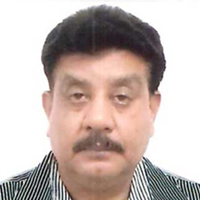Speakers Bio & Abstract

BiographyDr. S. K. Singh has illustrious career spanning over 26 years in the Survey of India.
He obtained his M.Tech. degree from the Jawahar Lal Nehru Technical University (JNTU), Hyderabad and thereafter completed Ph.D. from the Indian Institute of Technology, Roorkee. His field of specialisation has been geodesy, in which he has done Advance Course from the Indian Institute of Surveying & Mapping, Hyderabad. His field of research was development of geoid model.
During his career in the Survey of India he has been posted in various directorates and presently he has been posted as the Director, Geodetic & Research Branch, Survey of India. He was involved in execution of various projects of National importance viz., Determination of Transformation Parameters between Everest and WGS-84 datum, Earthquake monitoring in peninsular India etc. He has been associated with various international assignments e.g., Tunnel Alignment for Hydro-electric Projects in Bhutan, survey of Indo-Nepal boundary etc.
As a part of his present assignment, various projects of national importance such as National Hydrology Project, Indian Vertical Datum and Development of Geoid Model for Entire Country are being undertaken in the department.Abstract DEVELOPMENT OF GEOID MODEL - A CASE STUDY ON WESTERN INDIAThe word 'height' has no singular meaning. Ideally, the physical meaningful height should refer to the Geoid which is an equipotential surface of the earth's gravity field and closely approximates the mean sea level in global sense neglecting the long term effect of Sea Surface Topography (SST). However, practically, it is very difficult to establish such a surface due to the complexities involved. For all developmental and engineering projects, Mean Sea Level (MSL) based heights are required and accordingly contours on Survey of India topographical maps are based on MSL based heights which fulfill the criteria of water flow. Therefore, in India and also most of the countries, heights are computed with respect to locally determined MSL and are provided by levelling work which is very laborious and also time consuming. Survey of India has the mandate to establish & maintain reference stations of heights (known as Bench Marks) in the entire country. Accordingly, whole country is co
vered with such bench marks which are established with levelling of 1st order, 2nd order etc depending upon the accuracy achieved.
The GNSS (Global Navigation Satellite System) technique has achieved remarkable improvement in horizontal as well as vertical positioning. However, the heights resulted from GNSS data processing are called ellipsoidal heights (h). It has created a pressing desire for a similarly fast and accurate determination of orthometric heights (H). The task of transforming the ellipsoidal height (h) obtained from GNSS technique to the orthometric height (H) has prompted geodesists around the world to determine the geoid model which allows to bridge GNSS-derived geometrical (Ellipsoidal) heights (h) to meaningful physical (Orthometric) heights (H) in their region of interest by the relation, H = hGNSS - N. 'N'is known as geoid height or geoid undulation. Geoid modeling can be determined with basic input data of the acceleration of gravity near the Earth's surface (g).Survey of India has covered whole country with relatively dense gravity data.
Survey of India did a case study to compute hybrid geoid model over Western India in a region from 20° to 31° in latitude and 71° to 79° in longitude. Firstly, gravimetric geoid was computed with terrestrial gravity, satellite altimetry derived marine gravity, SRTM terrain data and best fitted Global Geopotential Model (GGM) in the region using Remove-Compute-Restore technique that involves spherical Fast Fourier Transformation (FFT) with optimized Stokes's kernel. 14 cm RMSE accuracy was achieved in gravimetric geoid. It was subsequently fitted by LSC method with data of GNSS observations on 1st order bench marks at 39 locations and was tested at 13 such locations within the model area to yield hybrid geoid model wherein a RMSE of 7 cm has been achieved. Survey of India now plans to develop precise hybrid geoid model of entire country in near future.